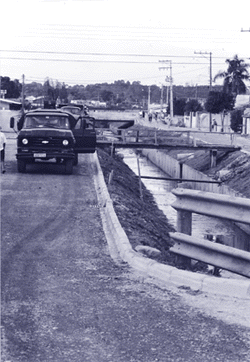|
Summary
Facing the Challenge of Natural Disasters: An IDB Action Plan
 The
Inter-American Development Bank is calling for concerted actions to address
the root causes of the region’s vulnerability. Its new focus would
place disaster prevention and mitigation at the forefront of the region’s
development agenda. Building on its mandate to promote sustainable development
in Latin America and the Caribbean, the Bank will help countries integrate
risk reduction in development planning and investments, as well as build
a permanent technical and operational capacity to manage risk reduction
more effectively in the future. The
Inter-American Development Bank is calling for concerted actions to address
the root causes of the region’s vulnerability. Its new focus would
place disaster prevention and mitigation at the forefront of the region’s
development agenda. Building on its mandate to promote sustainable development
in Latin America and the Caribbean, the Bank will help countries integrate
risk reduction in development planning and investments, as well as build
a permanent technical and operational capacity to manage risk reduction
more effectively in the future.
To meet the challenge
of increased risk and losses from natural disasters, the Bank will establish
a priority ranking of actions designed to reduce vulnerability. Financing
will be directed toward prevention and mitigation of disasters, as well
as building risk management capacity. Studies and regional dialogue to
identify and increase the understanding of good practices will complement
national efforts. Specifically, the Bank will assist countries in adopting
comprehensive risk management schemes by focusing on the following strategic
areas:
- National Systems
for Disaster Prevention and Response: Building national legal and regulatory
frameworks and programs that bring together the planning agencies, local
governments and civil society organizations; developing national strategies
for risk reduction, and assessing inter-sectoral priorities, backed
by separate budgets.
- A Culture of Prevention:
Developing and disseminating risk information and empowering citizens
and other stakeholders to take risk reduction measures.
- Reducing the Vulnerability
of the Poor: Supporting poor households and communities in reducing
their vulnerability to natural hazards and recovering from disasters
through reconstruction assistance.
- Involving the
Private Sector: Creating conditions for the development of insurance
markets; encouraging the use of other risk-spreading financial instruments
where appropriate, and designing economic and regulatory incentives
for risk reduction behavior.
- Risk Information
for Decision-Making: Evaluating existing risk assessment methodologies;
developing indicators of vulnerability, and stimulating the production
and wide dissemination of risk information.
- Fostering Leadership
and Cooperation in the Region: Stimulate coordinated actions and to
mobilize regional resources for investments in risk mitigation.
To effectively promote
these strategic areas in the region, the Bank faces the challenge of putting
risk management at the forefront of its agenda. A recent change in its
Policy on Natural Disasters, which now places greater emphasis on risk
reduction, lays the foundation to meet this challenge. The following Plan
of Action provides the elements for mainstreaming risk management in the
Bank’s operations and actions:
- A Facility for
Innovation in Disaster Prevention: Establishing new financial mechanisms
to help countries undertake and strengthen disaster prevention and risk
management actions.
- Risk Reduction
as a Component of the Bank’s Dialogue with member countries: Engaging
dialogue in areas of risk assessment, risk management strategies, and
the use of available IDB instruments for financing investments related
to natural disasters.
- Risk Reduction
in the Project Cycle: Including risk analysis and reduction in programming
and in project identification, design, implementation and evaluation.
- Focal Points for
Disaster Management: Supporting countries in preparing risk reduction
programs and coordinating prevention and response activities among the
Bank’s sector divisions and country offices.
- Partnerships:
Building an integrated information and response network that includes
coordinating the preparation of pre-investment studies; funding prevention
and reconstruction investments, and establishing interagency response
protocols.
|




